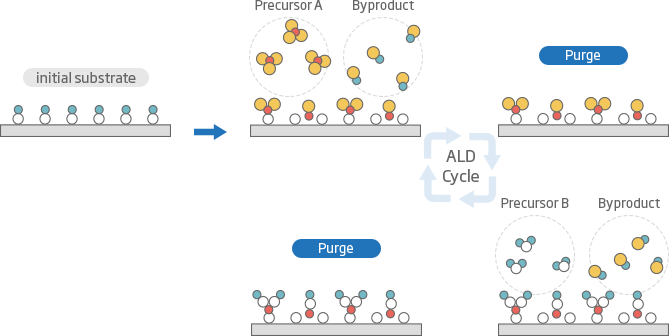ALD
ALD Basic
- saturated surface-controlled reaction
- Substrate is exposed to the first molecular precursor.
- The first molecular precursor is retained on the surface by chemisorption.
- Second precursor is introduced on the surface, which reacts on the surface of the first precursor.
- Exchange reaction takes place between the two precursors and by-products are formed.
- Exchange reaction continues till the second precursor reacts with first precursor.
- Final reaction : Precursor A + Precursor B → Film AB + by-products
- Sequence is repeated to grow films required.

Advantages
- Advantages of Atomic Layer Deposition
- Atomic layer deposition has several advantages over other techniques due to the actual mechanism used to deposit films.
- ALD is especially advantageous when film quality or thickness is critical.
- ALD is also quite effective at coating ultra high aspect ratio substrates or substrates that would be difficult to coat with other thin film techniques.
- Perfect films
-
- Digital thickness control to the atomic level by depositing film one atomic layer at a time-pinhole-free films, over very large areas
- Excellent repeatability
- Wide process windows(no sensitivity to temperature or precursor dose variations)
- Low-defect density
- Amorphous or crystalline, depending on substrate and temperature
- Digital control of sandwiches, hetero-structures, nanolaminates, mixed oxides, graded layers, and doping
- Insensitivity to particle
- Standard recipes for oxides, nitrides, metals, and semiconductors
- Conformal coating
-
- Perfect 3D conformality and 100% step coverage : uniform coatings on flat, inside porous, and around particle samples
- Flat and smooth coating that copies shape of substrate perfectly
- Large area thickness uniformity
- Easy batch scalability
- Challenging substrates
-
- Gentle deposition process for sensitive substrates, no plasma needed
- Low temperature deposition possible (RT~400˚C)
- Coats everything, even on teflon
- Excellent adhesion due to chemical bonds at the first layer
- Low stress due to molecular self-assembly
